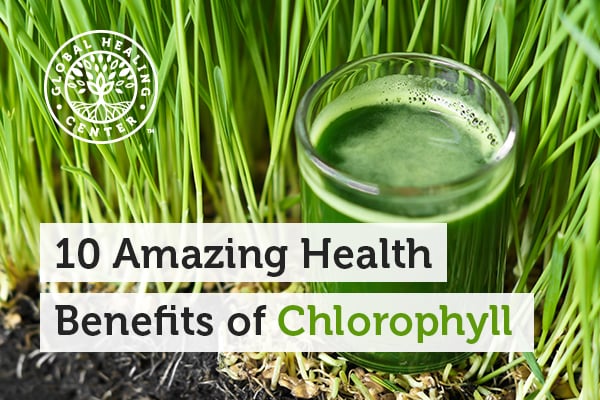
You may have heard a lot of buzz surrounding the healthiness of vegetables, especially leafy green vegetables with deep, rich color tones. In many ways, they're perfect foods and part of the credit is owed to the chlorophyll they contain. Chlorophyll is a green pigment that's instrumental in photosynthesis. It's what gives plants their green color. Research also suggests it's extremely beneficial for promoting good health.
Benefits of Chlorophyll
The following 10 benefits demonstrate its amazing versatility and power.
1. Helps Control Hunger and Cravings
Compounds containing chlorophyll might help suppress hunger, according to research. Twenty moderately overweight women were given test meals on three separate occasions one week apart — two meals with chlorophyll, one without. They reported reduced hunger following the meals containing the chlorophyll and blood tests showed stable blood sugar levels.[1] These results suggest chlorophyll should be considered as an effective way to manage hunger and promote weight loss.
2. Controls Body Odor
Chlorophyll is good for your body from the inside out, literally. This includes body and fecal odors. When tested in a nursing home with 62 patients, one study reported improvements in the odors emanating from the test subjects. In addition to odor reduction, taking chlorophyll was also associated with less constipation and gas.[2]
3. Encourages Healing
The use of chlorophyll to promote the healing process was first reported nearly 100 years ago. One older report published by Butler University — in 1950 — discussed its use for improving healing times.[3] A more recent study found that, when used as a spray, chlorophyll significantly helped wound therapy.[4] The research clearly backs its effectiveness in this area.
4. Promotes Cleansing
Environmental pollutants such as toxic metals can quickly destroy health. Chlorophyll binds with toxic metals to hamper absorption, and research has shown it can do the same with some carcinogens. A crossover study with 4 human volunteers tested chlorophyll’s ability to remove ingested aflatoxin, a known carcinogen. Each volunteer received three servings of the aflatoxin, followed with a meal, the latter two included a tablet of chlorophyll. The results showed rapid elimination with 95% evacuated within 24 hours.[5]
5. Protects DNA Against Fried Foods
Fried foods aren't just bad for your waistline, they also contain chemicals known to damage colon tissue and the DNA of colon cells. In one study, people who ate fried foods coupled with protective foods, including chlorophyll, were observed to have less DNA damage in their colon cells.[6] Don't take that as just cause to go crazy with the fried foods; the best idea is to avoid them altogether.
6. Super Potent Antioxidant Action
Chlorophyll's status as a superfood is due to its nutritional and potent antioxidant properties. It protects cells from oxidative damage by eliminating free radicals.[7] One plant known for its high chlorophyll levels, Conyza triloba, showed very active superoxide scavenging behavior. An in vitro study found this plant was capable of reducing free radicals while reducing cell damage.[8]
7. Promising Potential for Cancer Therapy
Although the research doesn't currently show that chlorophyll is a cancer cure, researchers are excited about its potential as a therapy. One study found men with lower levels of dietary chlorophyll had higher risks of colon cancer.[9] Another study noted it effective at stimulating liver detoxifying enzymes and may protect against other carcinogens.[10] That's a great reason to eat your green veggies!
8. Effective Against Candida albicans
Candida infection is a big concern for many individuals and can lead to fatigue, depression, and digestive concerns; just to name a few. Research has shown that isolated chlorophyll solutions stops growth of Candida albicans.[11]
9. Relieves Systemic Redness and Swelling
Traditional medicine has long used green leaves for infections. With modern approaches that have limited effectiveness and a long list of side effects, natural remedies are getting another look. Studies have found that consuming green leaves reduce swelling and redness in the body, which is linked to many disease conditions.[12]
10. Promotes Healthy Iron Levels
A modified form of chlorophyll known as chlorophyllin may be highly effective for anemia. By swapping iron for magnesium at the center of the molecule, it provides a bioavailable form of iron the body can use.[13] While scientists may look for ways to develop patentable medicines, no one has to wait to take chlorophyll to gain its benefits.
Points to Remember
Chlorophyll possesses an amazing range of benefits and is readily available to everyone. Chlorophyll rich foods are also healthy in their own right and contain essential vitamins and nutrients required for cardiovascular, muscular, and neural health. Consume foods containing chlorophyll or take a dietary supplement for best effect. Blue-green algae is one of my favorites. Wheatgrass, alfalfa, and leafy green vegetables like spinach also contain high levels of chlorophyll. You can also take it as a supplement in powder, drop, capsule, or juice form.
References (13)
- Stenblom EL, Montelius C, Östbring K, Håkansson M, Nilsson S, Rehfeld JF, Erlanson-Albertsson C. Supplementation by thylakoids to a high carbohydrate meal decreases feelings of hunger, elevates CCK levels and prevents postprandial hypoglycaemia in overweight women. Appetite. 2013 Sep;68:118-23. doi: 10.1016/j.appet.2013.04.022. Epub 2013 Apr 28.
- Young RW, Beregi JS Jr. Use of chlorophyllin in the care of geriatric patients. J Am Geriatr Soc. 1980 Jan;28(1):46-7.
- Esten, Mabel M. and Dannin, Albert G. (1950) "Chlorophyll therapy and its relation to pathogenic bacteria." Butler University Botanical Studies : Vol. 9, Article 21.
- Weir D, Farley KL. Relative delivery efficiency and convenience of spray and ointment formulations of papain/urea/chlorophyllin enzymatic wound therapies. J Wound Ostomy Continence Nurs. 2006 Sep-Oct;33(5):482-90.
- Jubert C, Mata J, Bench G, Dashwood R, Pereira C, Tracewell W, Turteltaub K, Williams D, Bailey G. Effects of chlorophyll and chlorophyllin on low-dose aflatoxin B(1) pharmacokinetics in human volunteers. Cancer Prev Res (Phila). 2009 Dec;2(12):1015-22. doi: 10.1158/1940-6207.CAPR-09-0099. Epub 2009 Dec 1.
- Shaughnessy DT, Gangarosa LM, Schliebe B, Umbach DM, Xu Z, MacIntosh B, Knize MG, Matthews PP, Swank AE, Sandler RS, DeMarini DM, Taylor JA. Inhibition of fried meat-induced colorectal DNA damage and altered systemic genotoxicity in humans by crucifera, chlorophyllin, and yogurt. PLoS One. 2011 Apr 25;6(4):e18707. doi: 10.1371/journal.pone.0018707.
- Zhang YL, Guan L, Zhou PH, Mao LJ, Zhao ZM, Li SQ, Xu XX, Cong CC, Zhu MX, Zhao JY. [The protective effect of chlorophyllin against oxidative damage and its mechanism]. Zhonghua Nei Ke Za Zhi. 2012 Jun;51(6):466-70.
- El-Sayed WM, Hussin WA, Mahmoud AA, AlFredan MA. The Conyza triloba extracts with high chlorophyll content and free radical scavenging activity had anticancer activity in cell lines. Biomed Res Int. 2013;2013:945638. doi: 10.1155/2013/945638. Epub 2013 May 23.
- Balder HF, Vogel J, Jansen MC, Weijenberg MP, van den Brandt PA, Westenbrink S, van der Meer R, Goldbohm RA. Heme and chlorophyll intake and risk of colorectal cancer in the Netherlands cohort study. Cancer Epidemiol Biomarkers Prev. 2006 Apr;15(4):717-25.
- Dingley KH, Ubick EA, Chiarappa-Zucca ML, Nowell S, Abel S, Ebeler SE, Mitchell AE, Burns SA, Steinberg FM, Clifford AJ. Effect of dietary constituents with chemopreventive potential on adduct formation of a low dose of the heterocyclic amines PhIP and IQ and phase II hepatic enzymes. Nutr Cancer. 2003;46(2):212-21.
- Lilian Eiko MAEKAWA, LAMPING Roberta, MARCACCI Sidnei, Marcos Yasunori MAEKAWA, Maria Renata Giazzi NASSRI, Cristiane Yumi Koga-Ito. Antimicrobial activity of chlorophyll-based solution on Candida albicans and Enterococcus faecalis. Revista Sul-brasiliera de Odontologia 01/2007.
- Subramoniam A, Asha VV, Nair SA, Sasidharan SP, Sureshkumar PK, Rajendran KN, Karunagaran D, Ramalingam K. Chlorophyll revisited: anti-inflammatory activities of chlorophyll a and inhibition of expression of TNF-? gene by the same. Inflammation. 2012 Jun;35(3):959-66. doi: 10.1007/s10753-011-9399-0.
- Miret S, Tascioglu S, van der Burg M, Frenken L, Klaffke W. In vitro bioavailability of iron from the heme analogue sodium iron chlorophyllin. J Agric Food Chem. 2010 Jan 27;58(2):1327-32. doi: 10.1021/jf903177q.
†Results may vary. Information and statements made are for education purposes and are not intended to replace the advice of your doctor. If you have a severe medical condition or health concern, see your physician.







